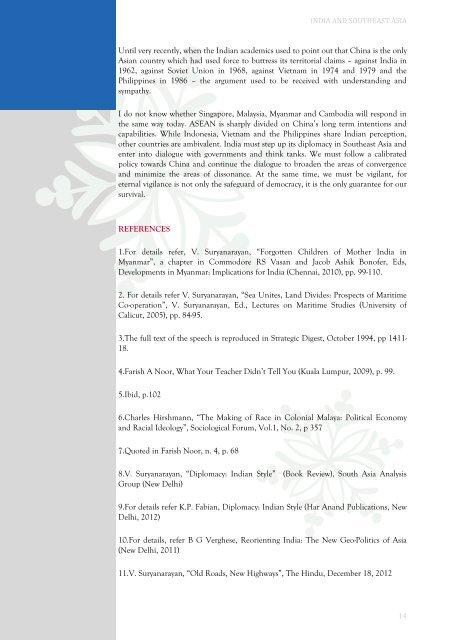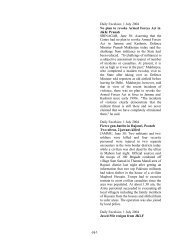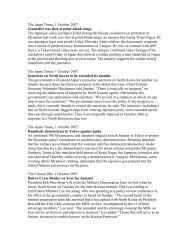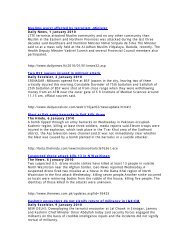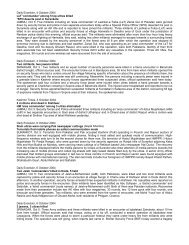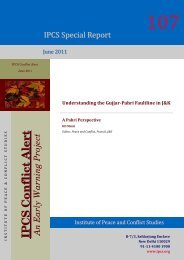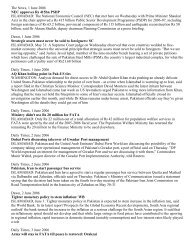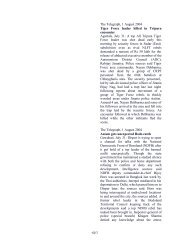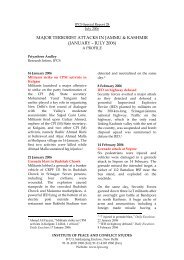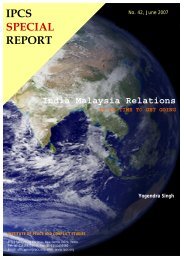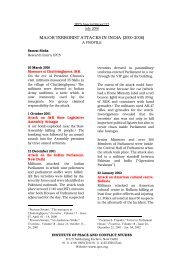India and Southeast Asia: A Personal Narrative from Chennai
India and Southeast Asia: A Personal Narrative from Chennai
India and Southeast Asia: A Personal Narrative from Chennai
You also want an ePaper? Increase the reach of your titles
YUMPU automatically turns print PDFs into web optimized ePapers that Google loves.
INDIA AND SOUTHEAST ASIA<br />
Until very recently, when the <strong>India</strong>n academics used to point out that China is the only<br />
<strong>Asia</strong>n country which had used force to buttress its territorial claims – against <strong>India</strong> in<br />
1962, against Soviet Union in 1968, against Vietnam in 1974 <strong>and</strong> 1979 <strong>and</strong> the<br />
Philippines in 1986 – the argument used to be received with underst<strong>and</strong>ing <strong>and</strong><br />
sympathy.<br />
I do not know whether Singapore, Malaysia, Myanmar <strong>and</strong> Cambodia will respond in<br />
the same way today. ASEAN is sharply divided on China’s long term intentions <strong>and</strong><br />
capabilities. While Indonesia, Vietnam <strong>and</strong> the Philippines share <strong>India</strong>n perception,<br />
other countries are ambivalent. <strong>India</strong> must step up its diplomacy in <strong>Southeast</strong> <strong>Asia</strong> <strong>and</strong><br />
enter into dialogue with governments <strong>and</strong> think tanks. We must follow a calibrated<br />
policy towards China <strong>and</strong> continue the dialogue to broaden the areas of convergence<br />
<strong>and</strong> minimize the areas of dissonance. At the same time, we must be vigilant, for<br />
eternal vigilance is not only the safeguard of democracy, it is the only guarantee for our<br />
survival.<br />
REFERENCES<br />
1.For details refer, V. Suryanarayan, “Forgotten Children of Mother <strong>India</strong> in<br />
Myanmar”, a chapter in Commodore RS Vasan <strong>and</strong> Jacob Ashik Bonofer, Eds,<br />
Developments in Myanmar: Implications for <strong>India</strong> (<strong>Chennai</strong>, 2010), pp. 99-110.<br />
2. For details refer V. Suryanarayan, “Sea Unites, L<strong>and</strong> Divides: Prospects of Maritime<br />
Co-operation”, V. Suryanarayan, Ed., Lectures on Maritime Studies (University of<br />
Calicut, 2005), pp. 84-95.<br />
3.The full text of the speech is reproduced in Strategic Digest, October 1994, pp 1411-<br />
18.<br />
4.Farish A Noor, What Your Teacher Didn’t Tell You (Kuala Lumpur, 2009), p. 99.<br />
5.Ibid, p.102<br />
6.Charles Hirshmann, “The Making of Race in Colonial Malaya: Political Economy<br />
<strong>and</strong> Racial Ideology”, Sociological Forum, Vol.1, No. 2, p 357<br />
7.Quoted in Farish Noor, n. 4, p. 68<br />
8.V. Suryanarayan, “Diplomacy: <strong>India</strong>n Style” (Book Review), South <strong>Asia</strong> Analysis<br />
Group (New Delhi)<br />
9.For details refer K.P. Fabian, Diplomacy: <strong>India</strong>n Style (Har An<strong>and</strong> Publications, New<br />
Delhi, 2012)<br />
10.For details, refer B G Verghese, Reorienting <strong>India</strong>: The New Geo-Politics of <strong>Asia</strong><br />
(New Delhi, 2011)<br />
11.V. Suryanarayan, “Old Roads, New Highways”, The Hindu, December 18, 2012<br />
14


